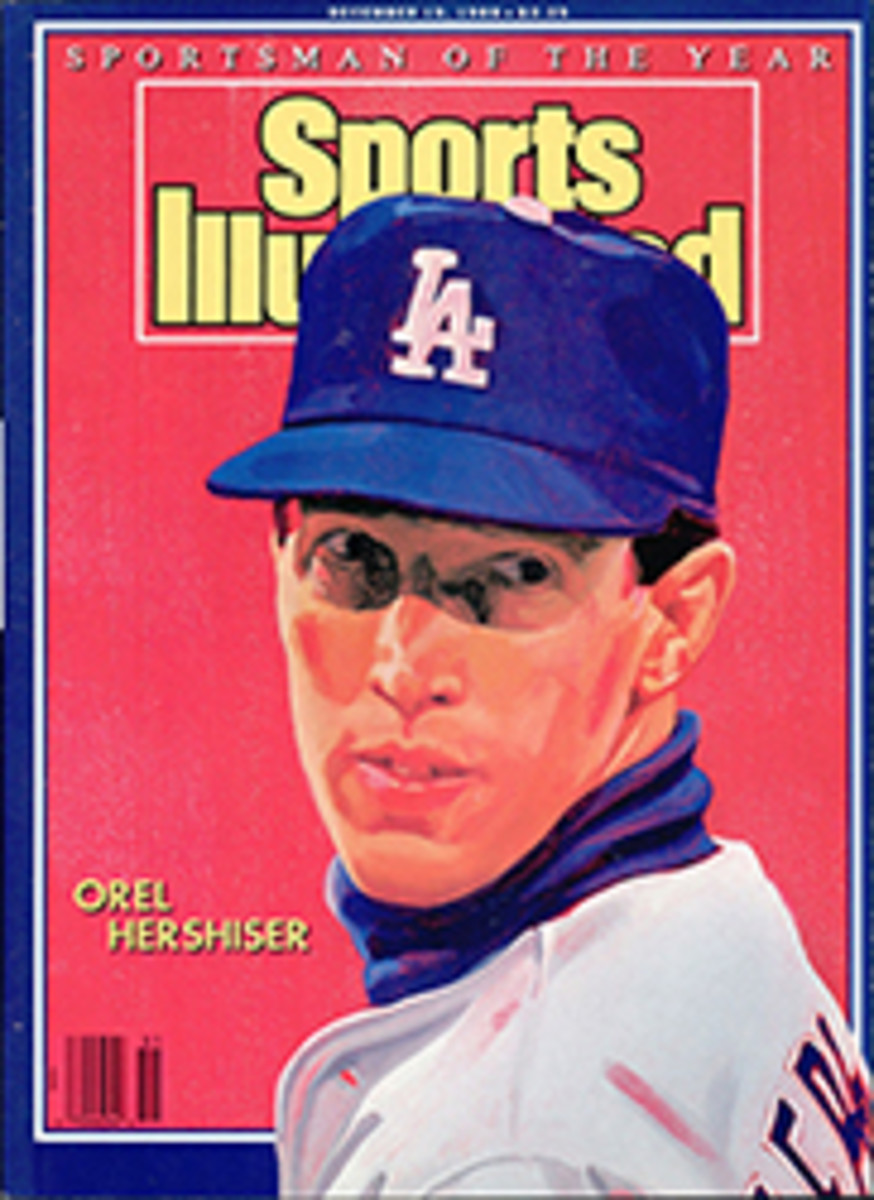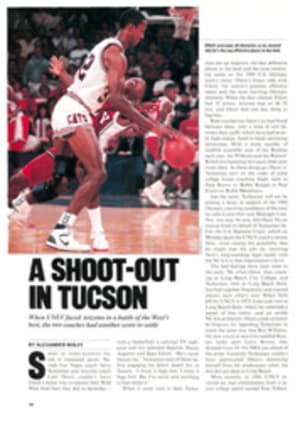
SCORECARD
THE TARKANIAN DECISION
It has taken more than 11 years, but the NCAA has finally made its point. The U.S. Supreme Court, in a 5-4 vote, ruled Monday that the NCAA acted with proper authority in 1977 when it, in effect, ordered the University of Nevada. Las Vegas, to suspend basketball coach Jerry Tarkanian for two years for flagrantly violating NCAA recruiting rules, encouraging individuals to impede an NCAA investigation by giving false information, certifying that his program was in compliance with NCAA rules when it wasn't and failing to exhibit high ethical standards. Tarkanian obtained a court order blocking the suspension and stayed on the job, enjoying as much success as any college coach in the country (page 46) while the issue was argued in the courts.
Tarkanian won all the early rounds. In 1987 the Nevada Supreme Court upheld a lower-court ruling that the NCAA had violated Tarkanian's constitutional rights by denying him due process. Tarkanian's lawyers pointed out that many of the NCAA's member schools, including UNLV, are state-supported institutions and are therefore governmental bodies. They further argued that because of its association with those schools, the NCAA should be deemed a governmental body too and hence be subject to the myriad constitutional limitations imposed on government interference with individual rights.
But the U.S. Supreme Court, which has the last word, disagreed. "The NCAA is properly viewed as a private actor at odds with the state when it represents the interests of its entire membership in an investigation of one public university," wrote Justice John Paul Stevens.
The decision apparently freed the NCAA to once again order UNLV to suspend Tarkanian and, presumably, to close down the Runnin' Rebels' basketball program if the school sticks by its earlier refusal to comply. Whether or not the NCAA will still try to punish Tarkanian, the decision generally strengthens the organization's hand in disciplining member schools. Of potentially even greater importance is what the decision might mean for the NCAA's efforts to impose drug tests on college athletes. Suddenly the legal minefields surrounding such tests seem less treacherous.
TRUMP-ETS, PLEASE
Donald Trump, whose Trump Organization owns Trump Tower, Trump Pare, Trump Plaza and the site that will become Trump Place in New York City, announced last week that he will promote a 10-day bicycle race that will pass in view of the Trump Castle Hotel and Casino in Atlantic City before finishing in front of the nearby Trump Plaza Hotel and Casino.
Trump, skipper of the Trump Princess, probable owner of an airline to be christened the Trump Shuttle, and author of Trump and Trump: The Art of the Deal, said he bristled when organizers first suggested that next May's race be named after him: "I said, 'You absolutely must be kidding.' "
They weren't, of course, and so Trump agreed—reluctantly—to lend his name to the nationally televised Tour de Trump.
RIVERFRONT RAG
Cincinnati is gaga over the Ickey Shuffle. A modest end-zone celebration that contains hints of both ballet and waltz, the shuffle is the creation of the Bengals' star rookie running back, Ickey Woods. He does it every time he scores, which has been 15 times in 15 games so far this season. The fans love it, and the officials, who technically should assess a penalty for this sort of thing, have been winking at Ickey's dancing. (They penalized the Bengals only when Ickey shuffled twice in Buffalo.) Even Paul Brown, Cincy's 80-year-old general manager, has been spotted doing the Ickey Shuffle in his office. He says his wife likes it.
Now the Shuffle has won critical acclaim. Dayton (Ohio) Daily News sports columnist Gary Nuhn arranged for his paper's dance critic, Terry Morris, to view the Shuffle and comment on it. Morris wrote in Nuhn's column: "His little divertissement is in such obvious good taste...and it's classic simplicity itself. He knows his terpsichorean limitations, and a critic can appreciate that. I say, encourage him. The world needs more dancing big men."
BON VOYAGE
Last Friday night, a day after signing as a free agent with the San Diego Padres for $5.25 million, Bruce Hurst, who pitched for the Boston Red Sox for the past nine seasons, did what he often does when the Celtics play at home: He went to watch his friend Danny Ainge perform.
Boston beat the Philadelphia 76ers 121-107 as Ainge scored a career-high 45 points, but the game was only a sideshow. The main event was in the stands, where Hurst became the target of angry abuse by members of the local lunatic fringe. The first reaction of the Boston Garden crowd to Hurst's appearance was a mild mixture of boos and applause, but in the second half, hecklers approached his seat, shook fingers and fists at him and shouted insults. Later a small but noisy group of fans sitting behind him began chanting, "Bruce Hurst sucks."
Hurst remained composed throughout the ordeal, staying in his seat for the whole game and even signing autographs for half an hour afterward. Among the Boston fans who approached to wish him well was an elderly woman who ruefully said, "Thanks to you, I'm going to die without seeing the Red Sox win a World Series."
FIRE SALE
Tickets for the second coming of Guy Lafleur to the Montreal Forum were the toughest in that city's sports history. By early last week, scalpers were fetching as much as $500 apiece for ducats to the game between the Canadiens and the New York Rangers on Dec. 17, the attraction being the dramatic homecoming of the balding, 37-year-old Lafleur, who led the Canadiens to five Stanley Cups. After a four-year retirement from the game, Lafleur returned to the ice this season with the Rangers.
On Saturday night, however, the bottom fell out of the scalpers' market. In a Rangers-Bruins game at the Boston Garden, Lafleur broke a bone in his left foot blocking a shot. Montreal's hero will be sidelined for 10 to 14 days, which means he won't be back on the ice until Dec. 20 at the earliest.
PRO STARS AS STOCKING STUFFERS
According to the wall street journal," It's going to be a blue christmas in toyland. With no "megabits" on the market this year—toy sensations that can be counted on to produce $100 million or more, such as the Cabbage Patch Kids—the toy industry, which does 60% of its business at Christmastime, will have to settle for a measly $13 billion in annual sales, an increase of only 4% or 5% over last year.
But the news isn't all bad. Scattered here and there on the list of the 20 top-selling toys, as compiled by Toy & Hobby World, are a few minihits that promise to dispel the Yuletide blahs for their makers. One of these is a series of five-inch-high action figures, selling for about $4 each, called Starting Lineup. The figures made their debut last summer and are now ranked ninth in sales nationwide. Sculpted and painted to resemble specific professional baseball and football players (260 different individuals so far), the plastic figures are being marketed by Kenner Products of Cincinnati as collectibles—three-dimensional baseball cards, if you will—which appeal to a broad audience. "By far the most frequent request we get is 'Can I buy the whole line?' " says Bruce Stein, Kenner's senior vice-president of marketing.
The idea for Starting Lineup came from Pat McInally, a Harvard man who retired as the punter for the Cincinnati Bengals in 1986 after a 10-year career. When McInally was preparing to leave Cincinnati for good, he sold his condominium there to Stein, and when the two were finished talking real estate, their conversation turned to toys. Stein invited McInally—who writes a syndicated newspaper column called "Pat Answers for Kids"—to come up with some toy ideas.
To that end, McInally's wife, Leslie, took her husband on a tour of a large toy store across the Ohio River in Florence, Ky. "There were toys called He-Men. GI Joe, all these make-believe characters," says McInally. "We looked at each other and said, 'Why are people spending money on these imaginary heroes when real heroes like Walter Payton and Marcus Allen are out there playing football every weekend?' "
The rest is toy biz history. After Christmas, Kenner's basketball lineup will hit the shelves, raising the total number of figurines to 360, and plans are in the works to expand into individual sports such as tennis. "It's neat to see my friends get a little piece of immortality," says McInally, who works for Kenner as an adviser on Starting Lineup and receives a royalty for each figure sold. "The downside is that the line features only active players, and next year it will expand to include Hall of Famers, which means I'll never have a figure done of me."
ILLUSTRATION
PATRICK McDONNELL
PHOTO
CRAIG MOLENHOUSE
Idea man Pat McInally plays Gulliver to his Lilliputian lineup of sporting heroes.
THEY SAID IT
•Scott Hastings, Miami Heat forward, on why he is frequently mentioned in the same breath with Larry Bird: "They say, 'Scott Hastings, he's no Larry Bird.' "
•Jerry Reynolds, coach of the floundering Sacramento Kings, signing off his TV show: "I'm Jerry Reynolds and aren't you glad you're not?"

